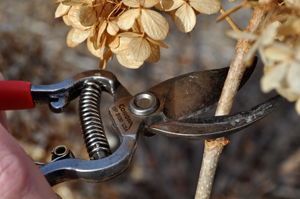Pruning shrubs in the spring
Return to Trees and Shrubs Agent Articles
 Spring explodes with color, making this season one of the best times of the year here in Kansas City. Bright, colorful blooms fill our senses and remind us of the renewal that spring brings. Unfortunately, this colorful display does not last long.
Spring explodes with color, making this season one of the best times of the year here in Kansas City. Bright, colorful blooms fill our senses and remind us of the renewal that spring brings. Unfortunately, this colorful display does not last long.The end of a shrub's flowering cycle triggers the time to prune. Now that spring flowering is over, it is time to prune.
Spring-flowering Shrubs
Shrubs that flower in the spring are normally pruned immediately after flowering. Examples of these types of plants include:
- forsythia,
- Vanhoutte spirea,
- quince,
- lilac, and
- mockorange.
Shrubs that Bloom on this Year's Growth
Shrubs that bloom on current season’s growth, or that do not produce ornamental flowers, are best pruned in late winter to early spring. Examples of these include:
- Rose of Sharon,
- Japanese spirea,
- butterfly bush,
- blue mist spirea and
- burning bush euonymus.
Three Correct Methods of Pruning
There are three basic methods used in pruning shrubs:
- Thinning,
- Heading back and
- Rejuvenation.
- cutting them back to a larger branch, or
- cutting them back to just above an outward facing bud.
On a multi-stemmed shrub, the oldest branches may be completely removed.
Heading back is removing the end of a branch by cutting it back to a bud. It is used to reduce the height, or to keep it compact. Branches are not cut back to a uniform height, as this will result in a “witches’ broom” effect. Instead, cut the branches back at random heights similar to that of the natural shrub shape prior to pruning.
Rejuvenation is the most severe type of pruning and is normally done during the dormant season. It is used on a multi-stemmed shrub that has become too large with many old branches. All the stems are cut back to 3 to 5 inches above the ground.
Rejuvenation works well for:
- spirea,
- forsythia,
- ninebark,
- mockorange,
- shrub roses, and
- quince.
Shearing is a No-no
Shearing shrubs is not considered a proper method of pruning. Shearing should only be done on formal hedges in the landscape.
Spring temperatures and timely rainfall make this a great time to prune flowering shrubs. You will be rewarded with lush growth and a great foliar display.

Have questions? The Garden Hotline is staffed by trained EMG volunteers and Extension staff who will assist you with questions.
Phone: (913) 715-7050
Email: garden.help@jocogov.org